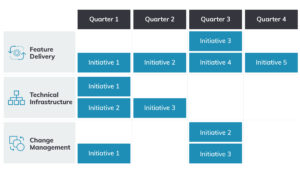Have you ever made a production plan but had a difficult time explaining it to your team or managers? A visual aid might assist in getting your plan across to your audience. Don’t fret. This is where a product roadmap can help.
Just as a traditional map gets you from point A to point B, a roadmap for business purposes also does the same. A product roadmap is a strategic communications tool that helps articulate a defined goal or desired outcome over a period of time. It also includes a high level overview of anticipated milestones needed to reach this defined goal. A product roadmap should be specific to your intended outcomes for each respective area you plan on mapping out. This tool differs from other project tools in that it should not contain granular details and should remain high-level enough to convey your intended outcome.
It is not a project plan, project schedule, or a product backlog.
Now that you have decided on a Road Map as a visual aid for your presentation, decide what you want your road map to show. A product roadmap is not a one size fits all design and should be configured to your team’s needs. The following items make up a simple Road Map.
- Initiatives – Road Maps should have high level initiatives with specific outcomes prioritized over a period of time. These initiatives should align to the product vision.
- Timeline – Road Maps should prioritize these initiatives over a period of time. This can be broken down by quarters, months, weeks, or days.
- Sections – Keep your Road Map organized to show a fluid progression. We recommend 3 sections to align the different aspects of your delivery in one visual document: Feature Delivery, Technical Infrastructure, and Change Management Engagement.
- Feature Delivery: The core part of any product is its features. At the top, key features should be prioritized. Prioritization can incorporate customer needs, competitive advantage, and business goals.
- Technical Infrastructure: Any product requires technical infrastructure updates. These can include Cloud or On-Prem server set up, security and scalability updates, modern architecture improvements, and data improvements. These items are separate from feature delivery and should still be prioritized and visualized on the roadmap.
- Change Management Engagement: The most critical part of delivering a solution is getting adoption – both internally and externally. Here, you should capture key activities such as employee retooling plans and communication activities such as public announcements and townhalls.
Here is an example of what your product roadmap could look like.

Lastly, as previously mentioned, do not confuse your Road Map with other useful project artifacts.
It’s not a backlog.
A backlog is essentially a to-do list of the tasks required to complete a strategic initiative identified on the roadmap. Roadmap planning is often the process of creating a high-level strategy out of a collection of backlog tasks and ideas.
It’s not a project management tracker.
Roadmaps should not be confused with the documents or artifacts used to create details that will be needed to complete the overall goal. Keep in mind a roadmap should remain a high level, living document.
Granular project details should be tracked and updated throughout any strategic undertaking. It is best to use a tool designed for this such as Trello, Pivotal Tracker, or JIRA.
It’s not a list of features.
Finally, many product managers mistakenly assume their planned list of features or user stories constitutes the roadmap itself. But this is not the case. Roadmaps should identify high level, strategic initiatives which will help achieve the Vision. These initiatives are then decomposed into the features and user stories which comprise your backlog.
Now that you know what a Road Map is and how to create one, feel free to tailor your Road Map to your specific objective. Remember to keep it simple, high level, and easily digestible for your audience to compliment your next big meeting.